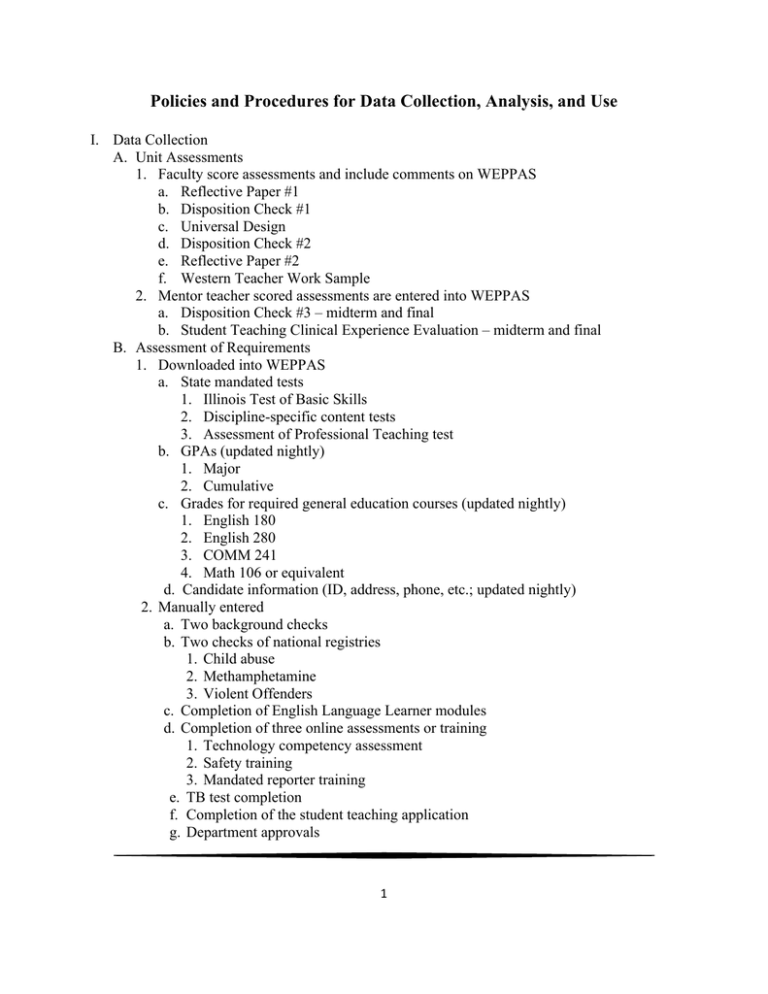Policies and Procedures for Data Collection, Analysis, and Use
advertisement

Policies and Procedures for Data Collection, Analysis, and Use I. Data Collection A. Unit Assessments 1. Faculty score assessments and include comments on WEPPAS a. Reflective Paper #1 b. Disposition Check #1 c. Universal Design d. Disposition Check #2 e. Reflective Paper #2 f. Western Teacher Work Sample 2. Mentor teacher scored assessments are entered into WEPPAS a. Disposition Check #3 – midterm and final b. Student Teaching Clinical Experience Evaluation – midterm and final B. Assessment of Requirements 1. Downloaded into WEPPAS a. State mandated tests 1. Illinois Test of Basic Skills 2. Discipline-specific content tests 3. Assessment of Professional Teaching test b. GPAs (updated nightly) 1. Major 2. Cumulative c. Grades for required general education courses (updated nightly) 1. English 180 2. English 280 3. COMM 241 4. Math 106 or equivalent d. Candidate information (ID, address, phone, etc.; updated nightly) 2. Manually entered a. Two background checks b. Two checks of national registries 1. Child abuse 2. Methamphetamine 3. Violent Offenders c. Completion of English Language Learner modules d. Completion of three online assessments or training 1. Technology competency assessment 2. Safety training 3. Mandated reporter training e. TB test completion f. Completion of the student teaching application g. Department approvals 1 1. Admittance to the Teacher Education Program (TEP) 2. Approval to student teach 3. Approval for certification II. Data Aggregation, Analysis and Use A. Candidate Level 1. Candidate data is automatically recorded in each candidate checklist when assessments are scored and/or entered into WEPPAS 2. System automatically sends candidate an email noting the addition of new checklist data 3. Candidates check WEPPAS as desired 4. Advisors monitor candidate progress on WEPPAS and use the data for advising purposes B. Program Level 1. Department chair/program designee/staff uses WEPPAS to generate aggregated data reports at the end of each semester. 2. Department faculty analyze aggregated data from key unit assessments and identify changes needed in courses and/or the program annually. 3. Program chair/designee presents aggregated data, faculty data analysis, and proposed program changes to the Assistant Dean/NCATE coordinator through the annual university and state reports. 4. NCATE Coordinator provides feedback to program faculty and program chair/designee. 5. Department faculty approve and implement planned changes. 6. Effects/results of approved changes are analyzed in the next annual university and state report cycle. C. Unit Level 1. NCATE Coordinator with assistance from staff uses WEPPAS to generate aggregated data for key unit assessments for all programs at the end of each semester. 2. Steering Committee reviews and analyzes the data noting overall strengths and weaknesses of unit programs annually. 3. Steering Committee makes recommendations for needed revisions in professional education and student teaching courses and/or key unit assessments as needed. 4. Steering Committee presents aggregated unit data, unit data analysis, and recommended unit changes to UTEC annually. 5. UTEC acts upon recommended changes. 6. The Assessment Subcommittee revises unit assessments and/or rubrics as required by the analysis of the data and directed by UTEC. 7. Changes that require revision of curriculum offered in programs are completed by the appropriate program(s). Appropriate university approvals will be obtained, if needed. 8. Approved changes are posted on the Teacher and Professional Education Preparation website for use by all faculty and programs. 9. Approved changes are implemented. 10. Effects/results of approved changes are analyzed in the next annual cycle. 2

